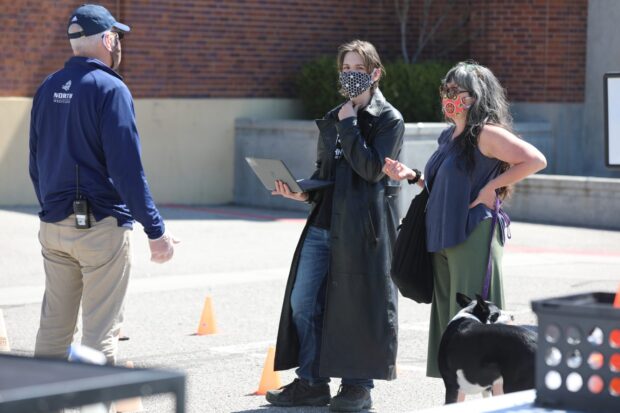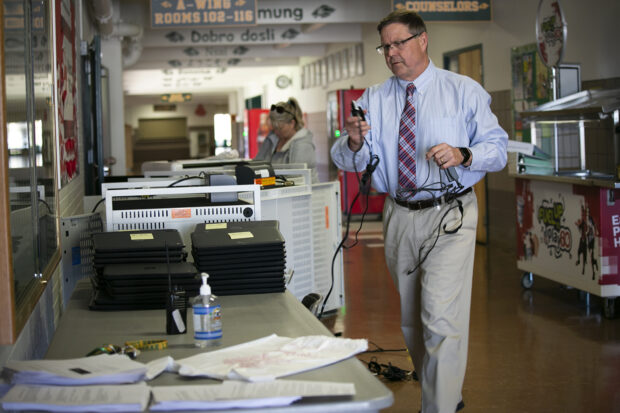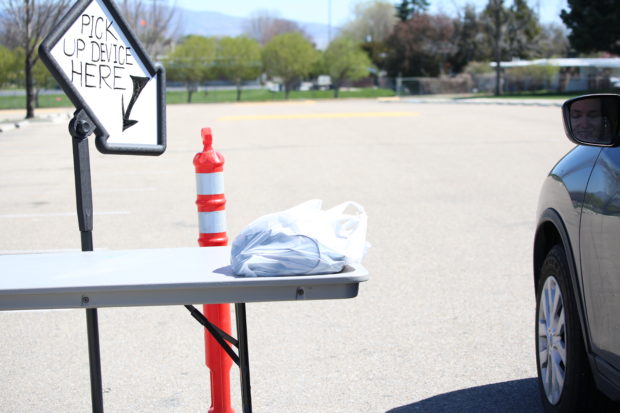A stream of cars pulled up bumper-to-bumper in front of Borah High School on Wednesday, almost as if nothing had changed.
Instead, they were there because everything has changed.
Rather than dropping off their children, parents were there to pick up Chromebooks for their kids, who are now learning from home as Idaho fights the spread of the novel coronavirus.
Idaho’s two largest school districts, Boise and West Ada, will begin their full-fledged remote learning programs next week, using a mix of online, digital and analog work. In advance of that rollout, the districts launched a mammoth communication effort, in an attempt to map which of their 65,000 students had access to computers and internet at home, and who needed those resources.
In the last two weeks, more than 3,000 educators attempted to reach every household with students in the Boise and Meridian districts. Tens of thousands of phone calls and emails later, they’ve begun to piece together a comprehensive picture of student access to online learning, one household at a time.
In the West Ada district, at least 2,300 high school students don’t have access to a computer with internet at home.
In Boise, some 6,000 students asked for a laptop so they can work from home.

Coronavirus is emphasizing the ‘digital divide’
A lack of access to a reliable computer or Internet at home has long been cited as a barrier for some students to access digital education resources. Yet it’s often an anecdotal one.
When coronavirus school closures pushed many districts to adopt online learning platforms, the question of student access went from hypothetical to critical.
“It’s about equity and access,” Hollar said. “Making sure that we level the playing field as much as we can for our families and identify what their needs are to be able to …provide equal access to education in this environment.”
Up to 17 percent of students say they are sometimes unable to finish homework because they don’t have a computer or Internet at home, according to the Pew Research Center. And 14 percent of high schoolers said they only have access to one device at home, most often a smartphone, in a study by the ACT Center for Equity in Learning.
The immediate consequence of this divide could mean kids can’t access the same information as their peers and fall behind in learning. Long term, students could be less prepared for college and the workforce if they’re not well versed in 21st century technology, said Raeal Moore the principal research scientist for the ACT.
Schools’ transition to online learning during the coronavirus crisis can further amplify these disparities where they already exist, Moore said.
The barriers that used to challenge kids after school are now a burden during the school day as well.
“It’s just an ever-present phenomenon now,” Moore said.

Mapping the need in Idaho’s largest districts
West Ada sent a survey to parents in March asking about their technology and Internet access.
The district got responses from about half of its households, or 19,000. That left another 20,000 to contact.
The Boise School district, with 25,000 students, had a similar workload.
Both districts asked teachers to call the kids in their classes. For elementary teachers, that meant connecting with their primary group of students. At the secondary level, teachers coordinated by calling the same class period — all touching base with their second period or third period classes, for example.
This week, both districts have some early data for the number of kids who need their help.
Boise found 6,000 students who wanted a computer to take home. The district had quick access to 17,000 Chromebooks, spokesman Dan Hollar said, so organizing device pickup was largely a matter of coordinating student information with computer serial numbers so the district can keep track of the laptops.
As of Tuesday, Boise was still working to pin down which students needed Internet access. The district planned to order 500 hotspots, and distribute Chromebooks with instructions on how to use cellphones as hotspots now that many cellular providers are offering unlimited data because of the pandemic. Boise Schools can also extend Internet into the parking lot to give students access.
The West Ada district does not have enough devices to give out to every student, spokesman Eric Exline said. The district’s priority is to get laptops or hotspots to the 2,379 high school students who need them, and to distribute paper work for students in lower grades who do not have Internet access.
“What we’re trying to do is provide remote learning for all kids. That’s our obligation and that’s what we’re working hard to accomplish,” Exline said.
Once the district has compiled the data on student access, Exline plans to map it using address information. That could give the district an idea of where to position hotspots to deliver Internet access to the most students in need, he said.
Despite a week of outreach, there were still families that Boise teachers hadn’t been able to connect with as of early this week, Hollar said. Educators are trying another round of outreach to those parents, and reaching out to friends of the families to see if they can help the district connect, he said.

Phase two: The rollout
As parents pulled up to the curb at Borah High, a sign directed them to call the office.
Inside the nearly empty school (and only a few hundred yards away) assistant principle Trevor McKenna answered, took an order for laptops, looked up the students who were requesting computers, then shouted the order to principal Tim Standlee down the hall.
Standlee grabbed a laptop and a charger and packed it into a bag with some paperwork. Then Standlee ran the bag to a table in the parking lot.
Once Standlee was back inside the building, the caller could pull up to the table, grab the bag and head out.
“I’m getting my steps in today,” Standlee said as he raced a computer outside.
Over the course of morning pickup hours, from 9-11 a.m., Standlee gave out about 100 laptops. The calls never stopped.
Of Borah High School’s roughly 1,500 students, 200 requested a laptop at home.
“The need isn’t always financial need, different households have different setups,” he said. “If it makes it easier for a kid to have his or her own device, we want to make sure they have that.”
Boise’s Melanie Strasser pulled up to the school mid-afternoon and called in for three laptops.
Strasser has six kids at home, four of whom are in school. They all share one desktop computer.
During the regular school year, her two high-school students and eighth grader fight over who gets access to the computer to do their homework in the evenings. And that was before the coronavirus sent all of them home.
“Just the fact that more school is exclusively online, there really is no way for them to all get it done,” Strasser said.
Since schools closed, Strasser said, she’s heard from multiple teachers calling to check up on her kids and offer resources, like the Chromebooks.
“It’s really useful that they’re doing this,” she said.
